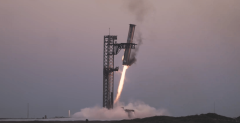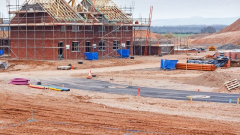No. But they don’t need to.
In preparation for the 5th test flight of Starship, SpaceX announced that they would try to catch the booster using “Mechazilla chopsticks.” Later during pre-launch discussions, SpaceX VP Bill Gerstenmaier claimed that they were confident of success since they had landed the booster in the ocean during Flight 4 with “half a centimeter accuracy.” And then last Sunday they went for the landing and nailed it!
But did they really nail it to within half a centimeter? That number sounds too good to be true, and it sparked quite a bit of skepticism from industry observers. What can SpaceX really expect for their landing accuracy?
My background: I am an aerospace engineer who has designed guidance, navigation, & control (GNC) systems for successful orbital launch vehicles, worked with RTK precision GPS systems on the ground, and implemented GNSS systems on satellite constellations. Standard disclaimer that I am only speaking for myself, and am only using public non-ITAR information. I don’t know what SpaceX is using to estimate the position and orientation on their rockets or their exact control schemes, and I might be missing some information that they’ve made public, but I am well versed in what goes into the design space and can hopefully make some good guesses. Please comment if I’m missing or misinterpreting anything.
So buckle in for an engineering deep dive and let’s look at what goes into controlling a rocket!
Main Points:
- Half a centimeter landing accuracy is not possible, and Bill likely misspoke or was talking about control error.
- SpaceX Super Heavy booster landing margins are so wide that you could land one with your smartphone electronics.
- Falcon 9 is likely harder to land.
- Catching the booster is an absolutely tremendous achievement that the team should be incredibly proud of!
Controlling Position
How Accurately Can SpaceX Measure Position?
The position of a rocket can be measured two primary ways. First, using GNSS (GPS) to get an absolute position. Second, by using accelerometers to estimate the distance from a known reference position (the launch pad).
The Super Heavy booster lands back in the chopsticks 7 minutes after launch. If we use a nice expensive IMU that has around 0.01 milli-g’s of accelerometer bias, that double integrates up to 8.6 meters of error. So flying by dead reckoning isn’t going to cut it. (This is a very quick-n’-dirty calculation – a real error propagation analysis would find a larger number due to velocity and attitude errors, so think of this as a lower bound).
We need to bring in GPS to get a better absolute position. Let’s look at the datasheet for high-end GNSS chips to get a sense of what’s feasible. Civilian GPS is the L1 band at 250 cm accuracy (looking at the 95% confidence sphere), and military GPS adds the L2 band to 240 cm accuracy, so note that even if SpaceX is using the military band that doesn’t do much on its own in an open-air environment. You could use SBAS (Satellite based augmentation systems, over the US it’s the WAAS system which airplanes use for landing at airports) which improves accuracy to 120 cm and is available through just the GPS satellite link. Going further than that requires communication between the booster and the ground. At the most precise, an RTK positioning system could lower position accuracy all the way down to 2.5 cm (+1cm per km of distance). If SpaceX put a receiver on the launch tower or the ocean bouys, then the landing position could be incredibly accurate. But even the most advance positioning tech won’t guarantee it down to 0.5 cm. And RTK does rely on being able to acquire and maintain a link between the booster and ground for this precision.

Sensor fusion with the accelerometer (aka Kalman filtering) will help fill any gaps in GNSS signals, provide higher rate estimates, and allow for identification & rejection of GNSS errors, but it won’t appreciably improve the absolute position error.
Furthermore, this is just the position of the GPS receiver on the rocket. How does that translate to the position of the landing pins? If there is angular pitch/yaw motion of the rocket, there will be a dynamic offset between the GPS antenna and the landing pins (though this can be calculated and compensated for). There will be manufacturing tolerances which may stack up to less than 5mm, but that would be incredibly tight for something this size. The booster itself will also change dimensions as it is cooled by propellant and heated by reentry. The coefficient of thermal expansion of steel is about 12 μm/m-degC, so for a 71 m booster with liquid oxygen at -183 degC and reentry temperature of (let’s say) 50 degC, that’s a 20 cm change in length. Cut that in half since the LOX tank is half the booster, and you still get 10 cm of elongation. It’s not clear to me whether the booster avionics are near the pins (in which case the local thermal deformation would be minimal) or the engines (in which case it definitely matters), but this shows that thermal effects alone could dwarf half a centimeter accuracy. Additionally, for the Flight 4 landing at sea which quoted the 0.5 cm number, movement of the bouys would be more than this.
SpaceX has said that they use radar altimeters to measure distance to the ground on Falcon 9 landings, which helps constrain the vertical axis error. That would help here as well, though the Super Heavy booster is coming down on an irregular pad rather than a flat landing zone, so a radar return signal would be harder to interpret reliably.
Could you use other real-time distance measurements like laser rangefinding or visual processing? I don’t think so – the surface of the vehicle is too irregular to get a reliable fix point, especially while it is moving, and these are vulnerable to smoke/fog/gas/ambient lighting. Technologies like Ultra Wideband are vulnerable to multipath reflections and attenuation by the booster’s steel walls, and aren’t more accurate than RTK anyway. It is possible that SpaceX has developed some proprietary techniques that provide more accurate localization information, but at this point we are speculating. And as we’ll see below, higher accuracy isn’t needed.
So 0.5 cm position accuracy is not possible with applicable technologies. I think the most likely scenario is that Bill misspoke and meant to say “half a meter” or “centimeters level accuracy” and conflated the two.

How Accurately Can SpaceX Control Position?
The algorithms here can get arbitrarily precise. I think < 10 cm accuracy is achievable, and 0.5 cm is impressive but not unbelievable. But this is only control of the vehicle relative to where it thinks it is. I think it’s also possible that this metric is what Bill was talking about, though it’s not the ultimate number that matters for landing.
In preparation for this landing attempt, SpaceX undoubtedly performed extensive Monte Carlo analyses, simulating the flight of the booster millions of times with different variations in vehicle properties, engine performance, environmental effects such as wind, contingency and off-nominal scenarios such as engine failures, timing errors and signal lag, etc. This would result in realistic landing accuracy numbers. Any estimate of how accurately SpaceX can position the rocket must be downstream of a full analysis like this that incorporates the dynamics of the landing event with all sources of uncertainty and error, and is well outside the scope of this post.
But we can bound the estimates by looking at Falcon 9 landings. Reddit user FortisVeritas collected the locations of Falcon 9 landings and made the plot below. Looking at just the green landing locations on land (in order to remove the extra error from landing on a moving droneship), they tend to land in approximately a 5-10 meter wide area (the large yellow circle on the landing zone is ~20 meters wide).

However, Falcon 9 has several disadvantages relative to the Super Heavy booster:
- It does not have separate landing propellant tanks, so propellant slosh will disturb its trajectory. The Super Heavy booster has dedicated central header tanks for landing propellant, so there should be minimal propellant slosh to disturb the vehicle attitude.
- It lands with a single engine which cannot throttle low enough to hover the vehicle, and as such must perform a “hoverslam” maneuver to bring the vehicle to a stop right on the ground. While the Super Heavy booster must perform most of a hoverslam maneuver to slow down just before coming in to the tower, it can hover for the final fine positioning.
- Because it lands with a single engine, roll control is minimal close to touchdown when the airspeed is low and the grid fins can impart minimal torque, and is limited to its weaker cold-gas thrusters. The Super Heavy booster can control roll with its 3 engines all the way to the ground.
- Falcon 9 has no engine-out capability for landing. SpaceX has not confirmed it for the Super Heavy booster, but I believe one engine out is likely possible (more on this later).
- It is smaller with a lower moment of inertia. Rockets get more stable and easier to control the larger they are, much like it’s easier to balance a broom on your finger than a pencil.
- It is smaller, and so thanks to the cubed-square law has a higher area:mass ratio. This means that it will be more affected by wind gusts that might blow it off course.
All this to say that the Super Heavy booster should be easier to control precisely than Falcon 9, and its landings more accurate than a ±2.5 meter range.
How Accurate Does SpaceX Need Position To Be?
Pulling from Ryan Hansen’s excellent video where he modeled and simulated the Super Heavy catch system, the below arc is the feasible catch zone for the booster. This area is 22 m at its narrowest point, and needs to fit a 9 m booster in it, so this allows for ± 6.5m of side-to-side error. The catch arm area is 18 m long, so call that ± 9 m of front-to-back accuracy required.

This side-to-side error range does assume that the catch arms can still close around the booster if it is off-center – can the tower can adjust the arm positions in real time so it doesn’t knock into one side of the rocket first and push it over? In the video below it certainly looks like this is the case. The left arm moves first and we see them come in at different speeds to keep centered around the booster in real time. They start moving before the rocket is between the arms, so I don’t expect this is being controlled by tower sensors such as radars mounted on the arms.
Vertical distance is likely to be the most constrained. If the engines shut off several meters above the arms, the booster would hit with quite a bit of force and in the worst case may bounce back off. There are pistons on the catch rails that could allow for damping out the impact from a dropped booster, but you still want to avoid this. The way to mitigate this is to center the booster in the right spot and then drop down slowly at a speed which you know is manageable for a successful catch. This is what we see SpaceX do. The limiter here becomes fuel – dropping at a steady speed burns as much as hovering. If you are dropping at 1 m/s, can you do that for 5 seconds? It’s not clear how much fuel margin SpaceX has here. The engines turns off immediately after cont





